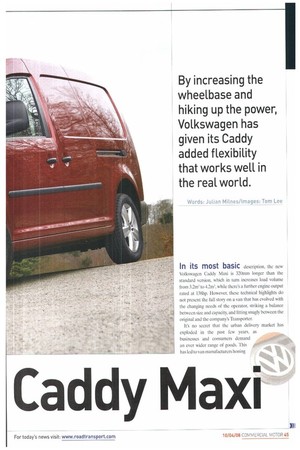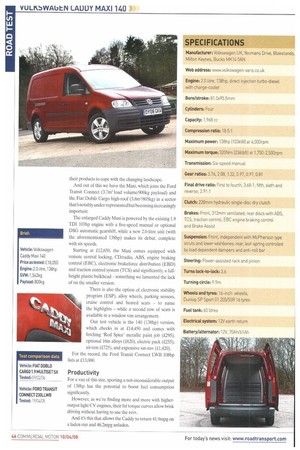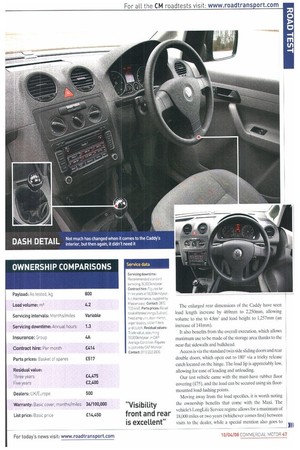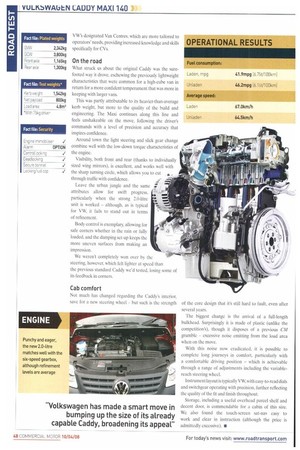Volkswagen Caddy Maxi
Page 44

Page 45

Page 46

Page 47

Page 48

If you've noticed an error in this article please click here to report it so we can fix it.
In its most basic
_ description, the new Volkswagen Caddy Maxi is 320mm longer than the standard version, which in turn increases load volume from 3.2m3 to 4.2m3, while there's a further engine output rated at I38hp. However, these technical highlights do not present the full story on a van that has evolved with the changing needs of the operator, striking a balance between size and capacity, and fitting snugly between the original and the company's Transporter.
It's no secret that the urban delivery market has exploded in the past few years, as businesses and consumers demand an ever wider range of goods. This has led to van manufacturers honing their products to cope with the changing landscape.
And out of this we have the Maxi, which joins the Ford Transit Connect (3.7m3 load volume/900kg payload) and the Fiat DoblO Cargo high-roof (3.8m3/805kg) in a sector that's notably under-represented but becoming increasingly important.
The enlarged Caddy Maxi is powered by the existing 1.9 TDI 103hp engine with a five-speed manual or optional DSG automatic gearshift, while a new 2.0-litre unit (with the aforementioned 138hp) makes its debut. complete with six speeds.
Starting at £12,650, the Maxi comes equipped with remote central locking, CD/radio, ABS, engine braking control (EBC), electronic brakeforce distribution (EBD) and traction control system (TCS) and significantly, a fullheight plastic bulkhead — something we lamented the lack of on the smaller version.
There is also the option of electronic stability program (ESP), alloy wheels, parking sensors, cruise control and heated seats — to name the highlights — while a second row of seats is available in a window van arrangement.
Our test vehicle is the 140 (138hp) version, which checks in at £14,450 and comes with fetching 'Red Spice' metallic paint job (f295), optional 16in alloys (£620), electric pack (£255), air-con (025), and expensive sat-nay (f1,420).
For the record, the Ford Transit Connect LWB 108hp lists at £13,000.
Productivity For a van of this size, sporting a not-inconsiderable output of 138hp has the potential to boost fuel consumption significantly, However, as we're finding more and more with higheroutput light CV engines, their fat torque curves allow brisk driving without having to use the revs.
And it's this that allows the Caddy to return 41.9rnpg on a laden run and 46.2mpg unladen. The enlarged rear dimensions of the Caddy have seen load length increase by 469nun to 2,250mm, allowing volume to rise to 4.8rie and load height to 1,257rrim (an increase of 141mm).
It also benefits from the overall execution, which allows maximum use to be made of the storage area thanks to the near-flat sidewalls and bulkhead.
Access is via the standard twin side sliding doors and rear double doors, which open out to 180° via a tricky release catch located on the hinge. The load lip is appreciably low, allowing for ease of loading and unloading.
Our test vehicle came with the must-have rubber floor covering (£75), and the load can be secured using six floormounted load-lashing points.
Moving away from the load specifics, it is worth noting the ownership benefits that come with the Maxi. The vehicle's LongLife Service regime allows for a maximum of 18,000 miles or two years (whichever comes first) between visits to the dealer, while a special mention also goes to VIV's designated Van Centres, which are more tailored to operators' needs, providing increased knowledge and skills specifically for CVs.
On the road What struck us about the original Caddy was the surefooted way it drove, eschewing the previously lightweight characteristics that were common for a high-cube van in return for a more confident temperament that was more in keeping with larger vans.
This was partly attributable to its heavier-than-average kerb weight, but more to the quality of the build and engineering. The Maxi continues along this line and feels unshakeable on the move, following the driver's commands with a level of precision and accuracy that inspires confidence.
Around town the light steering and slick gear change combine well with the low-down torque characteristics of the engine.
Visibility, both front and rear (thanks to individually sized wing mirrors), is excellent, and works well with the sharp turning circle, which allows you to cut through traffic with confidence.
Leave the urban jungle and the same attributes allow for swift progress, particularly when the strong 2.0-litre unit is worked — although, as is typical for VW, it fails to stand out in terms of refinement.
Body control is exemplary, allowing for safe corners whether in the rain or fully loaded, and the damping set-up keeps the more uneven surfaces from making an impression.
We weren't completely won over by the steering, however, which felt lighter at speed than the previous standard Caddy we'd tested, losing some of its feedback in corners.
Cab comfort Not much has changed regarding the Caddy's interior, save for a new steering wheel — but such is the strength of the core design that its still hard to fault, even after several years.
The biggest change is the arrival of a full-length bulkhead. Surprisingly it is made of plastic (unlike the competition's), though it disposes of a previous CM grumble — excessive noise emitting from the load area when on the move.
With this noise now eradicated, it is possible to complete long journeys in comfort, particularly with a comfortable driving position — which is achievable through a range of adjustments including the variablereach steering wheel.
Instrument layout is typically VW, with easy-to-read dials and switchgear operating with precision, further reflecting the quality of the fit and finish throughout.
Storage, including a useful overhead parcel shelf and decent door, is commendable for a cabin of this size. We also found the touch-screen sat-nay easy to work and clear in instruction (although the price is admittedly excessive). •












































































































































































































